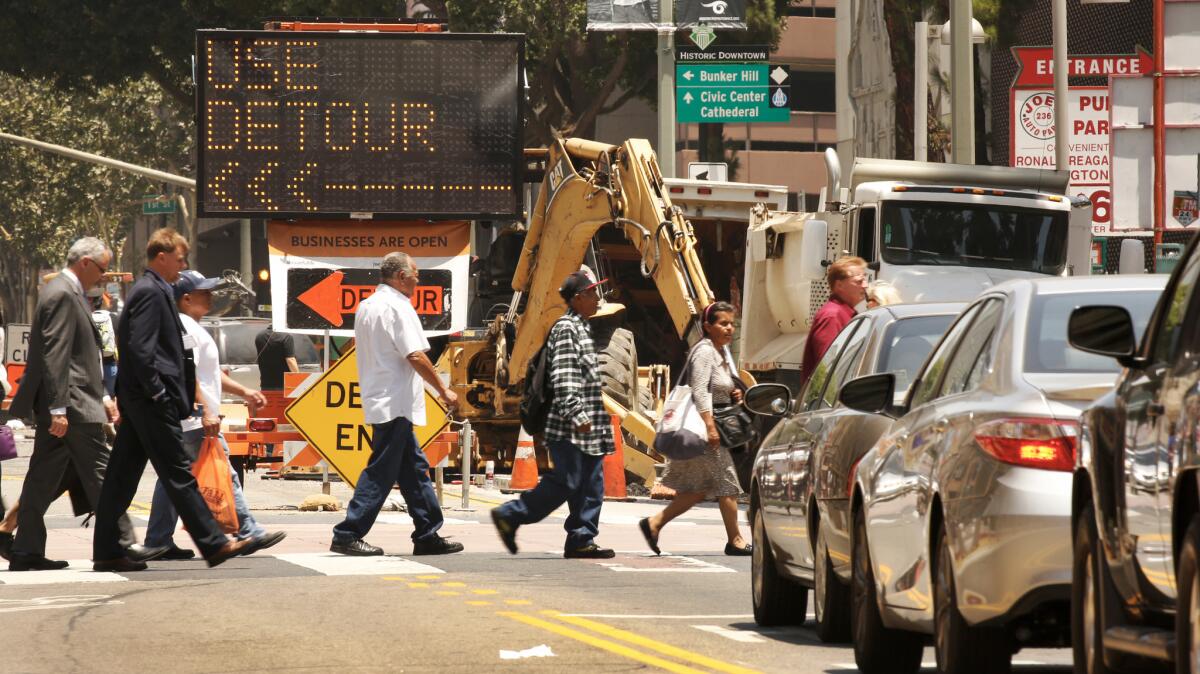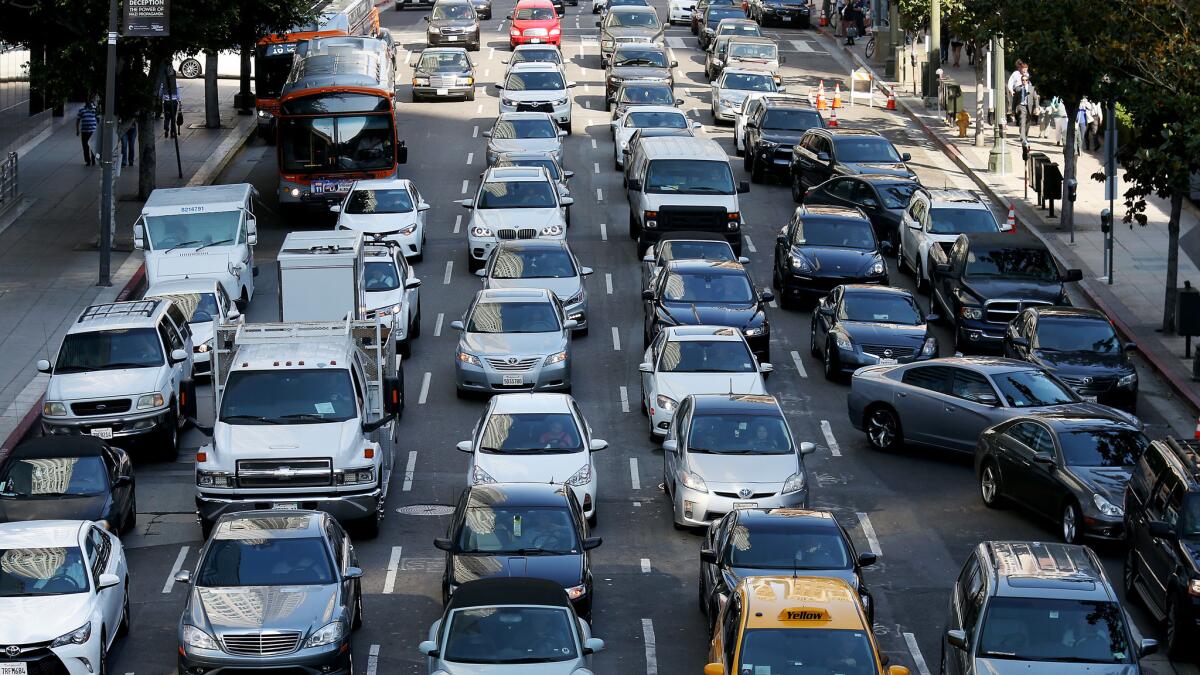Downtown L.A. traffic is getting worse — and to some, that’s good news

- Share via
Near Los Angeles City Hall on a recent morning, dozens of commuters attempted a slow and messy merge as three lanes of traffic narrowed to one.
Several drivers nosed into the intersection as the light turned red, prompting a shout from a white-gloved traffic officer and honks from other commuters suddenly trapped in gridlock.
A mile away, traffic backed up across the 4th Street bridge and into Boyle Heights as commuters who sought an alternate route to two other bridge closures ran into a bottleneck.
Driving through downtown Los Angeles has never been a breeze, but some frustrated commuters say waiting 10 to 15 minutes to travel a few blocks through the Central City is becoming commonplace.
After decades of relative quiet, downtown is teeming with commercial and residential life. The growth, coupled with a strong economy and a surge in construction, has sparked what residents and commuters say is some of the worst traffic they can remember.
Numerous high-rise towers are now under construction, including one that will be the West Coast’s tallest, as is another subway project that will snake between Union Station and the west side of downtown. Add that to regular construction and filming, and traffic really starts to back up.
Gridlock “is almost like an Easter egg — you never know where it’s going to pop up,” said Kt McBratney, 33, whose commute from Glassell Park to West Los Angeles takes her through downtown surface streets every weekday. “If I don’t run into any traffic, it almost feels like something is wrong.”
It’s difficult to measure just how much longer it now takes to navigate downtown, because city officials don’t perform regular, system-wide traffic counts.
But over a two-year period, the number of lane- and street-closure permits issued by the city rose by 147%, from 43 in March of 2014 to 106 in March of this year, according to a Times analysis.
The increases were most dramatic for permits related to construction, which soared 181% over that period, from 32 in 2014 to 90 this year.

Those figures reflect the growing popularity of the area neighborhood and the strength of the local economy, which has encouraged developers to resume long-dormant construction and start new projects, experts say. That includes the Metropolitan Transportation Authority subway project and several new skyscrapers, including the 73-story Wilshire Grand.
“From our perspective, traffic is good news,” said Carol Schatz, the president and chief executive officer of the Central City Assn. of Los Angeles.
Although her downtown business group’s members complain about a variety of issues, she said, traffic is not one of them, because it’s “a small price to pay for creating a real, vibrant downtown in the second-largest city in America.”
At a recent City Hall function, a state assemblyman said he counted a dozen cranes towering over the skyline.
Traffic in downtown Los Angeles has been the subject of complaints and hand-wringing for nearly a century. For years, the dense area was the undisputed center of fledgling Los Angeles, drawing workers, shoppers and theater-goers on streetcars and, eventually, in more and more cars.
As downtown’s supremacy declined after World War II, traffic patterns shifted toward the morning and afternoon commutes. Now, the pattern has become more complex.
Much of the development boom of the last decade has been in housing, creating a new class of downtown residents that now number more than 60,000. And a thriving arts, dining and nightlife scene draws thousands more after work hours end, adding more cars and people to the mix.
Since 1999, when the Los Angeles City Council approved a policy that made it easier to convert former business and industrial buildings into apartments, condos and retail spaces, downtown’s population has soared.
That boom appears to be continuing. More than 10,000 condos and apartments units are under construction in downtown, of which 4,000 are expected to open this year, Schatz said.
Other construction includes infrastructure investment: mainly, the Metro Downtown Regional Connector, a 1.9-mile subway project that will knit together three light-rail lines between Union Station and a rail hub at 7th and Flower streets.
In a push to make up lost time as delays and cost overruns mount, Metro closed a full intersection at Broadway and 2nd Street, a rare juncture of two two-way streets, to move data and power lines.
Drivers steering around that closure have run into severe delays on 3rd Street, which feeds through a narrow tunnel and toward the freeway on-ramps.
“It’s just like this traffic sewer,” said Max Podemski, 32, who lives at 3rd and Spring and works in Pacoima. Until the city added traffic officers along the street, he said, he sometimes waited 15 minutes to drive two blocks.
The Metro closure has also forced buses off Broadway, the transit spine of downtown, and onto nearby streets.
The rate of buses arriving within five minutes of their scheduled times in downtown has dropped by more than 3 percentage points over a year, from 76.7% in May of 2015 to 73.6% this year, according to agency data.
Those delays, spokesman Dave Sotero said, appear to be partially caused by construction and “more drivers and traffic,” as well as seasonal swings in commuting patterns.
Jason Stein, 41, who lives in Granada Hills and works at a law firm downtown, said the worst part of driving isn’t the delays, but not knowing where the next lane closure is going to strike.
The Transportation Department lists some event-related road closures on its website, but doesn’t include construction activity.
“It seems like it should be easier to know what’s happening and where,” Stein said.
The traffic app Waze has a somewhat better idea, but the app, which largely depends on user-submitted reports of road closures, tends to miss smaller construction incidents, particularly early in the day.
“I’ve personally ended up trapped because I can see a sign that says ‘detour,’ but only after it’s too late to turn,” McBratney of Glassell Park said. “Like, that is in 100 feet. Thanks for the heads up.”
McBratney said taking the bus to the Expo Line downtown, then the train to West L.A., would take more time than driving from Glassell Park, even during rush hour.
“The bus is at the mercy of traffic, too,” she said. “It doesn’t seem like it would save me any time.”
There are two major ways to reduce traffic, experts say. The first is through a recession, which sparks layoffs, meaning fewer people commute to work.
The second is a charge to use the roads or to park. London adopted a so-called “congestion pricing” program in 2003, charging drivers a daily rate to enter the central city. Over a 10-year period, the number of kilometers driven in the city fell by 11%, while population growth and transit use soared, according to transportation authorities.
Still, making driving more painful would be an unpopular proposal to many Angelenos who feel that it’s bad enough already.
“That’s the dark side of planning — the stick, rather than the carrot,” said Podemski, who is the planning director at the nonprofit organization Pacoima Beautiful. Los Angeles, he said, “is giving people the carrot, by investing in transit, but we aren’t giving them the stick, by making parking harder to find.”
ALSO
U.S. auto sales expected to hit record in first 6 months
Traffic deaths surged in 2015 as driving hit new record
L.A. clears a path for $1.2-billion bond measure to pay for homeless initiatives
More to Read
Sign up for Essential California
The most important California stories and recommendations in your inbox every morning.
You may occasionally receive promotional content from the Los Angeles Times.











